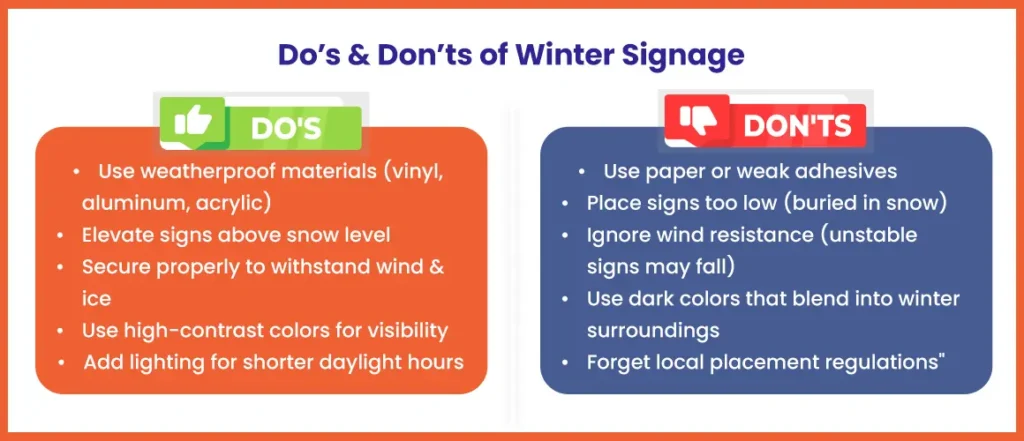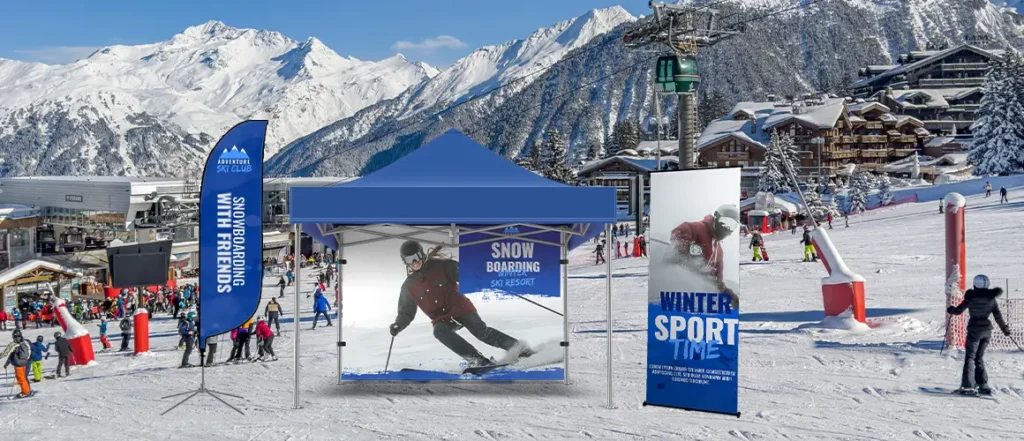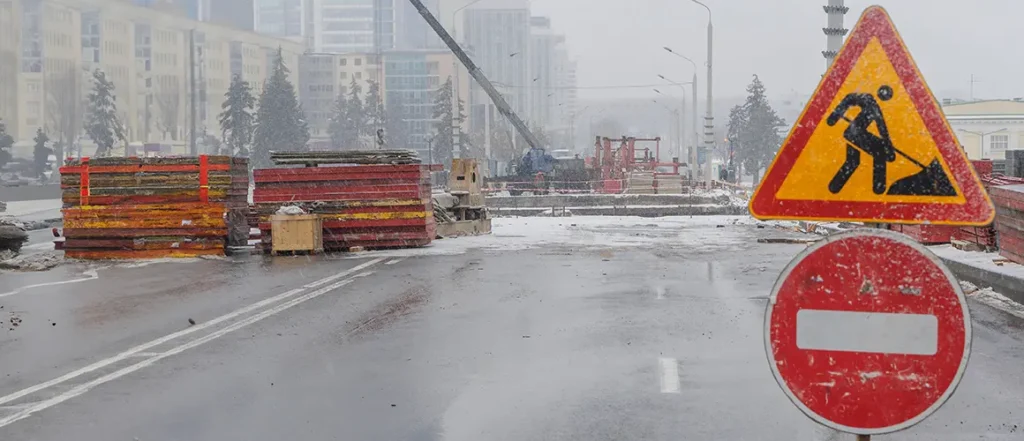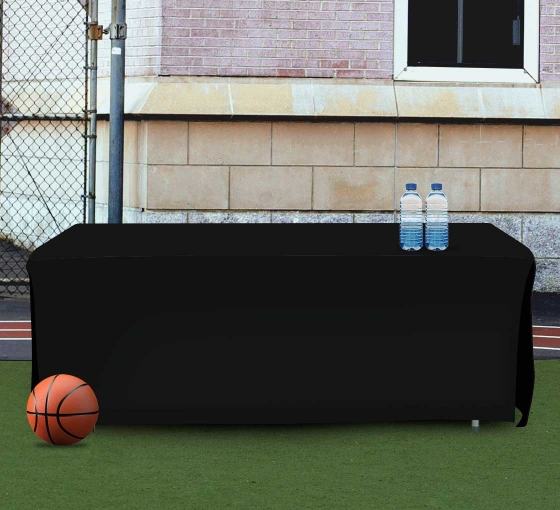Are your business signs ready to withstand the challenges of winter? Snow, ice, and freezing temperatures can reduce visibility, damage materials, and impact the effectiveness of outdoor signage. Without proper planning, signs may fade, crack, or become obscured by snowbanks, leading to missed opportunities for customer engagement. Whether you’re promoting seasonal sales, guiding visitors, or maintaining brand presence, winter conditions demand strategic sign placement to ensure durability and visibility.
Understanding the do’s and don’ts of winter signage for businesses and events can help you avoid costly mistakes and keep your signs functional throughout the season. From selecting weatherproof signage solutions to positioning signs where they remain visible and secure, small adjustments can make a big difference. In this guide, we’ll explore the best practices for cold weather sign placement, helping businesses maintain their outdoor presence without constant maintenance or replacements.

The Do’s of Winter Sign Placement
1. Choose Weather-Resistant Materials
Selecting the right material is critical for winter signage. Durable options such as vinyl, aluminum, coroplast, and PVC are ideal choices because they withstand moisture and temperature fluctuations. Weatherproof signage solutions can further enhance longevity and protect against fading, cracking, or warping.
2. Ensure Proper Installation
Strong winds and snowfall can dislodge or damage improperly secured signs. For outdoor banners, use heavy-duty grommets, reinforced stitching, and sturdy stands. Wall-mounted or pole-mounted signs should have secure fastenings that can endure strong gusts and heavy precipitation.

3. Optimize Visibility Against Snow and Fog
Contrast is key in winter settings. White or light-colored backgrounds can blend into snowy landscapes, reducing readability. Instead, opt for bold, dark colors with high-contrast text to ensure visibility against the winter backdrop. Reflective finishes or LED-lit signage can further enhance clarity in foggy or low-light conditions. The impact of winter weather on sign visibility should always be considered when designing outdoor signage.
4. Position Signs Strategically
Snowbanks and icy buildup can obstruct signage. Place signs at eye level or higher to prevent them from being buried under accumulated snow. Freestanding signs should be positioned away from high-traffic areas where plows or shoveling may cause obstruction or displacement. Cold weather sign placement strategies help prevent visibility issues and ensure signage remains effective.
5. Regularly Inspect and Maintain Signage
Routine checks help identify damage before it worsens. Look for cracks, peeling, fading, or water damage. Remove ice buildup and clear obstructions to maintain optimal visibility. If using LED-lit signs, ensure electrical components remain dry and functional. How to protect signs from snow and ice should be a priority for businesses to avoid frequent replacements.
6. Use Flexible and Temporary Signage for Changing Conditions
Businesses with frequent promotions or shifting messages should consider using interchangeable signage. Retractable banners, magnetic signs, and A-frame boards provide versatility and can be quickly relocated indoors during severe weather conditions.
The Don’ts of Winter Sign Placement
1. Avoid Weak or Non-Durable Materials
Paper-based signs, thin plastics, or untreated wood are susceptible to warping, tearing, and disintegration in winter weather. Using subpar materials leads to frequent replacements and increased costs.
2. Don’t Place Signs in High-Wind Areas Without Reinforcement
Open areas with strong winds require extra stability. Signs that aren’t reinforced may bend, tear, or become dislodged, causing potential safety hazards. Always secure signage with weighted bases, heavy-duty frames, or wind slits to reduce pressure buildup.
3. Avoid Placing Signs Where Snow or Ice Accumulates
Positioning signs in low-lying areas where snow and ice build up can obscure messaging and cause structural damage. Additionally, ice accumulation on hanging signs can add excessive weight, leading to bending or breakage.
4. Don’t Ignore Lighting Requirements
Shorter daylight hours mean reduced visibility for signage. Signs that lack illumination may go unnoticed. Backlit signs, spotlights, or LED-lit options ensure visibility even in early mornings or late evenings.
5. Never Overlook Local Regulations and Safety Codes
Different municipalities have varying regulations regarding outdoor signage, especially in winter conditions. Ensure compliance with local codes to avoid fines or the need for sudden repositioning. Additionally, signs should not obstruct pathways, exits, or important visibility points.
6. Avoid Using Adhesive-Based Signs in Freezing Temperatures
Vinyl decals and adhesive-backed signs can lose their stickiness in cold weather, leading to peeling and detachment. Instead, opt for rigid mounts or mechanical fastenings that can withstand temperature fluctuations.
Best Signage Options for Winter Conditions
| Sign Type | Key Features | Best Uses |
| Vinyl Banners | Water-resistant, flexible, reinforced edges | Outdoor promotions, storefronts |
| Aluminum Signs | Rust-proof, durable, withstands extreme cold | Permanent signage, wayfinding |
| Acrylic/Polycarbonate | Sleek design, impact-resistant | Storefront displays, branding |
| LED-Lit Signs | Illuminated, high visibility | Night-time advertising, main signage |
| A-Frame Signs | Portable, changeable inserts | Sidewalk promotions, menu boards |
Winter Signage Tips for Business Owners

- Plan Seasonal Messaging in Advance: Update promotions, sales, and directional signs before peak winter conditions set in.
- Test Signage Durability: Conduct stress tests on outdoor signs to ensure they hold up against wind and moisture.
- Use Professional Printing Services: High-quality printing prevents fading and ensures branding remains intact despite exposure to harsh elements.
- Leverage Indoor Signage as Backup: If extreme weather disrupts outdoor signage, use window decals, digital displays, and interior posters to maintain customer engagement.
- Invest in Portable Signage for Flexibility: Roll-up banners and magnetic signs offer adaptability for changing conditions. Best outdoor signs for winter include durable, weather-resistant materials designed to withstand extreme elements.
Conclusion
Winter signage requires careful planning to ensure durability, visibility, and effectiveness. Businesses must choose the right materials, secure placement strategies, and conduct routine maintenance to keep signs functioning optimally. By following these winter signage tips, businesses can maximize their signage impact throughout the winter season without unnecessary replacements or safety concerns.
From choosing sturdy materials to positioning signs away from high-snow areas, implementing best practices ensures your business signage remains a powerful marketing tool all year round.
Written By BannerBuzz Editorial Team.
























 Posted in
Posted in 













